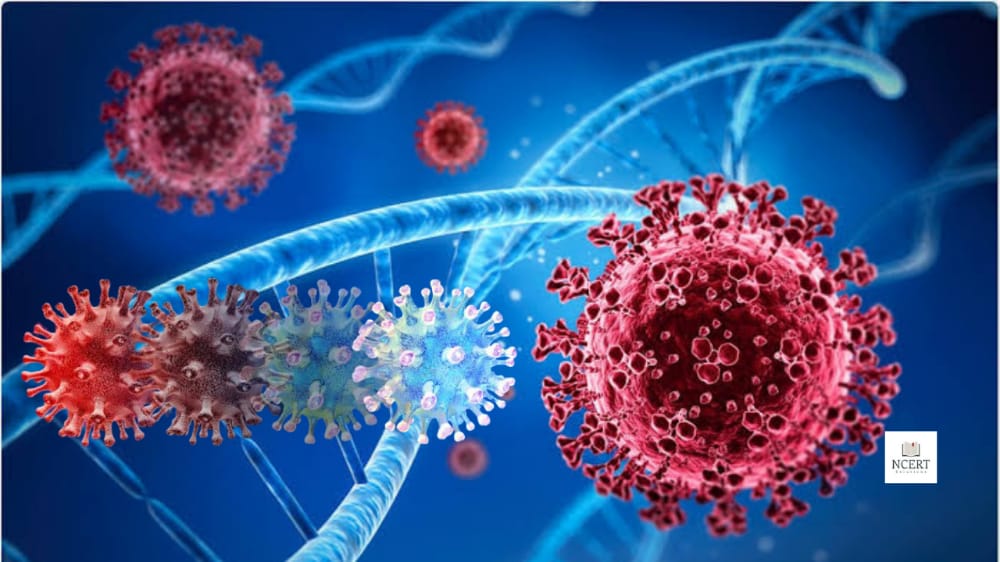Mutations in viruses can lead to significant changes, impacting their behavior and our ability to control them. These changes can sometimes create more contagious strains or resistant to treatments.
What is Mutation?
A mutation is a change in the DNA sequence of an organism. It can happen due to errors during cell division or exposure to certain chemicals or radiation. Mutations can cause changes in how genes function and can have significant effects on the organism. For instance, in the case of sickle cell anemia, a single mutation leads to the production of abnormal hemoglobin, affecting the shape of red blood cells.
Why do Viruses Mutate?
Viruses mutate to adapt and survive under selective pressures. DNA viruses mutate slowly, while RNA viruses, like the coronavirus and influenza virus, mutate rapidly due to a lack of proofreading during replication. According to the Centers for Disease Control and Prevention (CDC), RNA viruses can accumulate mutations quickly, leading to new variants.
Related: What is the importance of DNA copying in reproduction?
Effects of Viral Mutation
Mutations can make viruses more or less virulent. For example, the SARS-CoV-2 virus has evolved into different strains with varying levels of contagiousness and severity. The World Health Organization (WHO) monitors these changes and provides updates on new variants that may pose significant public health risks.
Weather and Viral Mutation
There is no strong evidence linking viral mutations to weather changes. Influenza, for example, spreads in both cold and tropical climates. A study published in the Journal of Clinical Microbiology and Infection suggested that the lack of vitamin D during winter may weaken immunity, leading to higher susceptibility to respiratory infections.
Duration of Outbreaks
Mutations alone do not necessarily prolong outbreaks. Harmful mutations may reduce a virus’s ability to spread, while beneficial mutations might help it survive under selective pressures. According to the CDC, the mutation rate of RNA viruses like SARS-CoV-2 remains within a range where it can be either advantageous or disadvantageous to the virus’s survival.
Re-infection with Different Strains
Different strains of a virus can re-infect individuals. For example, recovering from one strain of the flu does not guarantee immunity against other strains. Similarly, dengue virus has multiple serotypes, and infection with one does not provide long-term immunity against others, potentially leading to severe secondary infections.
Co-infection with Multiple Strains
It is possible to be infected with multiple strains simultaneously, leading to the creation of new strains. This has been observed in influenza viruses. The 2009 swine flu pandemic was caused by a strain containing a mixture of genetic material from swine, human, and avian flu viruses.
Can Viruses be Killed?
Viruses are not living organisms but can be inactivated outside a host using disinfectants containing alcohol or by enhancing population immunity through vaccination. The CDC states that ethyl and isopropyl alcohol can inactivate most viruses.
Drug Resistance and Viral Mutation
Viruses can develop drug resistance if not completely eradicated from the body. Resistance occurs due to selective pressures that favor mutations allowing the virus to evade drug effects. For example, a study shows, that the HIV virus has shown resistance to certain antiretroviral drugs due to mutations.
Vaccine Effectiveness
Vaccines can protect against multiple strains of a virus. For instance, the flu vaccine is designed to protect against several strains that are expected to circulate each year. The WHO recommends the composition of flu vaccines annually to match the most common circulating strains.
FAQ
Q.1: What is a Mutant?
A mutant is an organism or virus in which a mutation has occurred.
Q.2: Who is the Father of Mutation?
Hugo de Vries is considered the father of mutation theory.
Q.3: Who Discovered the Mutagenic Properties of Mustard Gas?
Auerbach and Robson discovered the mutagenic properties of mustard gas.
Q.4: If a Virus Mutates, Will the Outbreak Last Longer?
Not necessarily. While mutations can lead to new variants, they do not always result in prolonged outbreaks. Many factors, including public health interventions and immunity levels, play a role.
Q.5: Can Two Strains of a Virus Infect One Person at the Same Time?
Yes, co-infection with multiple strains can occur and has been documented in influenza viruses.
Q.6: Can the Same Medicine Work if the Virus Mutates?
It depends. Drug resistance can develop if mutations occur in the virus’s replication process, rendering some medications less effective.
Q.7: Do Vaccines Protect Against Most Strains of a Virus?
Yes, vaccines are designed to protect against multiple strains, though their effectiveness can vary depending on the match between the vaccine and circulating strains.
For more detailed information on viral mutations, check out our article on Viral Mutation and learn how they compare to gene-level mutations and their implications on health.
